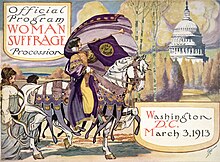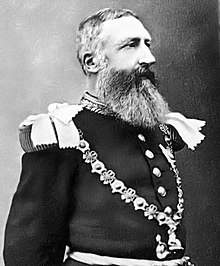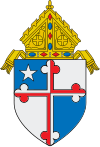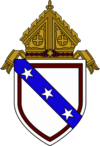| His Eminence James Gibbons | |
|---|---|
| Cardinal Archbishop of Baltimore | |
 | |
| See | Archdiocese of Baltimore |
| Appointed | May 29, 1877 (coadjutor) |
| Installed | October 3, 1877 |
| Term ended | March 24, 1921 |
| Predecessor | James Roosevelt Bayley |
| Successor | Michael Joseph Curley |
| Other post(s) | Cardinal-Priest of Santa Maria in Trastevere |
| Previous post(s) | Bishop of Richmond (1872–77) |
| Orders | |
| Ordination | June 30, 1861 by Francis Kenrick |
| Consecration | August 15, 1868 by Martin John Spalding |
| Created cardinal | June 7, 1886 by Leo XIII |
| Rank | Cardinal-Priest |
| Personal details | |
| Born | (1834-07-23)July 23, 1834 Baltimore, Maryland |
| Died | March 24, 1921(1921-03-24) (aged 86) Baltimore, Maryland |
| Motto | Emitte spiritum tuum (Send forth your spirit) |
| Signature | |

James Cardinal Gibbons (July 23, 1834 – March 24, 1921) was an American Catholic prelate who served as Apostolic Vicar of North Carolina from 1868 to 1872, Bishop of Richmond from 1872 to 1877, and as Archbishop of Baltimore from 1877 until his death.
Gibbons was consecrated a bishop on August 16, 1868, at the Baltimore Cathedral. The principal consecrator was Archbishop Martin J. Spalding. He was 34 years of age, serving as the first apostolic vicar of North Carolina. He attended the First Vatican Council in Rome where he voted in favor of defining the dogma of papal infallibility.
In 1872, Gibbons was named Bishop of Richmond by Pope Pius IX. In 1877, Gibbons was appointed Archbishop of Baltimore, the oldest episcopal see in the United States. During his 44 years as Baltimore's archbishop, Gibbons became one of the most recognizable Catholic figures in the country. He defended the rights of organized labor and helped convince Pope Leo XIII to give his consent to labor unions. In 1886, Gibbons was appointed to the College of Cardinals, becoming the second cardinal in American history, after Cardinal John McCloskey, archbishop of New York.
Early life and education
James Gibbons was born on July 23, 1834, in Baltimore, Maryland, the fourth of six children, to Thomas and Bridget (née Walsh) Gibbons. His parents were from Tourmackeady, County Mayo, in Ireland. The family left Ireland to settle in Canada, then moved to the United States.
After contracting tuberculosis in 1839, Thomas returned with the family back to Ireland, hoping the Irish climate would help him recover. He opened a grocery store in Ballinrobe, where James Gibbons worked as a child. Slight of build and a little under than average height, James Gibbons suffered from gastric problems and consequent periods of anxiety and clinical depression. Thomas Gibbons died in Ireland in 1847; in 1853, Bridget Gibbons moved the family back to the United States, settling in New Orleans, Louisiana.
While attending a Catholic retreat in New Orleans, Gibbons heard a sermon by Reverend Clarence A. Walworth, co-founder of the Paulist Fathers. Inspired to become a priest, Gibbons in 1855 entered St. Charles College in Ellicott City, Maryland. After graduating from St. Charles in 1857, he went to St. Mary's Seminary in Baltimore. He suffered a severe attack of malaria while at St. Mary's, leaving him so debilitated that the staff doubted his ability to handle the priesthood.
Priesthood
Having recovered from his malaria, Gibbons was ordained a priest on June 30, 1861, for the Archdiocese of Baltimore by Archbishop Francis Kenrick at St. Mary's Seminary. After Gibbons' ordination, the archdiocese assigned him as curate at St. Patrick's Parish in the Fells Point section of Baltimore for six weeks. They then named him the first pastor of St. Brigid's Parish and as pastor of St. Lawrence Parish, both in Baltimore. During the American Civil War, Gibbons served as a chaplain for Confederate Army prisoners at Fort McHenry in Baltimore.
In 1865, Archbishop Martin Spalding appointed Gibbons as his personal secretary. Gibbons helped Spalding prepare for the Second Plenary Council of Baltimore in October 1866. At Spalding's prompting, the Council fathers recommended the Vatican created an apostolic vicariate for North Carolina and appoint Gibbons head to it.
Episcopal career
Apostolic Vicar of North Carolina

On March 3, 1868, Pope Pius IX appointed Gibbons as the first apostolic vicar of North Carolina and titular bishop of Adramyttium. He received his episcopal consecration on August 15, 1868, from Spalding, with Bishops Patrick Lynch and Michael Domenec serving as co-consecrators, at the Cathedral of the Assumption in Baltimore Cathedral. At age 34, he was one of the youngest Catholic bishops in the world and was known as "the boy bishop."
Gibbons' vicariate contained fewer than 700 Catholics spread over the state of North Carolina. During his first four weeks in office, he traveled almost a thousand miles, visiting towns and mission stations and administering sacraments. During his road trip, Gibbons befriended many Protestants, and was invited to preach at Protestant churches. Gibbons made a number of converts to Catholicism. Gibbons became a popular American religious figure, gathering crowds for his sermons on diverse topics that could apply to Christianity as a whole. Over his lifetime, Gibbons met every American president, from Andrew Johnson to Warren G. Harding, and served as an adviser to several of them.
During the Second Plenary Council in 1866, Gibbons advocated for the creation of a Catholic university in the United States to educate priests and laymen. However, the proposal remained in limbo for the next 19 years.
In 1869 and 1870 Gibbons attended the First Vatican Council in Rome. Gibbons voted in favor of the doctrine of papal infallibility. He assumed the additional duties of apostolic administrator for the Diocese of Richmond, Virginia, in January 1872.
Bishop of Richmond
Gibbons was named by Pius IX as the fourth bishop of the Diocese of Richmond on July 30, 1872. He was installed as bishop on October 20, 1872.
Coadjutor Archbishop and Archbishop of Baltimore
On May 29, 1877, Pius IX named Gibbons as coadjutor archbishop of the archdiocese of Baltimore. He automatically succeeded as archbishop on October 3, 1877, after the death of Archbishop James Bayley. For the first twenty years of his administration, Gibbons had no auxiliary bishop to assist him. He therefore travelled extensively throughout the archdiocese, coming to know the priests and parishioners very well.
Cardinal Priest


On June 7, 1886, Pope Leo XIII created Gibbons as a cardinal priest and on March 17, 1887, assigned him the titular church of Santa Maria in Trastevere. He was the second American cardinal after Cardinal John McCloskey.
In 1885, the bishops in the Third Plenary Council in Baltimore decided to build the Catholic University of America in the District of Columbia. The university opened on March 7, 1889, with Gibbons serving as its first chancellor.
In 1903, Gibbons became the first American cardinal to participate in a papal conclave. He would have participated in the 1914 conclave but he arrived late.
During World War I, Gibbons was instrumental in the establishment of the National Catholic War Council. He allowed Reverend William A Hemmick to serve American troops in France during the war. Hemmick became known as the patriot priest of Picardy. At the end of the war, Gibbons supported American participation in the new League of Nations.
James Gibbons died on March 24, 1921, in Baltimore at age 86.
Viewpoints
Americanism
Main article: AmericanismIn 1899, Gibbons became embroiled in a controversy with the Vatican about a biography of Reverend Isaac Hecker, the founder of the Paulist Fathers. A biography, Life of Isaac Hecker, had recently been published in French. The Vatican decided that the preface to the French edition contained controversial opinions about individualism and liberalism. The translator, Abbé Félix Klein, had attributed those views to Hecker. The book inflamed an ongoing dispute over Americanism, liberal attitudes on obedience to papal authority in the United States that the Vatican considered a heresy.
On January 22, 1899, Leo XIII sent Gibbons an encyclical, Testem benevolentiae nostrae ("Concerning New Opinions, Virtue, Nature and Grace, with Regard to Americanism"). The encyclical condemned the Hecker biography for Americanism. In response, Gibbons and other American church leaders assured the pope that the opinions in the book preface belonged to Klein, not Hecker. They further asserted that Hecker never promoted any deviation from or minimization of Catholic doctrines.
Relations with Jews

During his tenures in North Carolina, Virginia and Maryland, Gibbons established cordial relationships with local rabbis. In an 1890 letter, Gibbons said:
For my part I cannot well conceive how Christians can entertain other than most kindly sentiments toward the Hebrew race, when I consider how much we are indebted to them. We have from them the inspired volume of the Old Testament which has been consolation in all ages to devout souls. Christ our Lord, the Founder of our religion, His Blessed Mother, as well as the apostles, were all Jews according to the flesh. These facts attach me strongly to the Jewish race.
In 1890, Gibbons condemned pogroms targeting Jews in the Russian Empire. In 1903, he condemned the Kishinev pogrom in present day Chișinău, Moldova, in which rioters killed 49 Jews and injured hundreds more. He pleaded for the public to assist Russia's Jews. When Jewish leaders in 1915 in Ohio were opposing a state law that would promote bible readings in public schools, Gibbons sent them a letter of support. During World War I, he supported American Jewish Relief fundraising in Baltimore.
Women's suffrage

Gibbons initially opposed the women's suffrage movement in the United States. However, when the nineteenth amendment to the US Constitution passed in 1920, allowing women to vote, Gibbons urged women to exercise that right, describing it "...not only as a right but as a strict social duty."
Organized labor
Gibbons advocated for the protection of working people and their right to organize in labor unions. He believed that industrials in America's eastern cities were exploiting Catholic immigrant workers. He was once quoted as saying, "It is the right of laboring classes to protect themselves, and the duty of the whole people to find a remedy against avarice, oppression, and corruption." Gibbons played a key role in the granting of papal permission for Catholics to join labor unions.
Regarding manual labour Gibbons said that "the Savior of mankind never conferred a greater temporal boon on mankind than by ennobling and sanctifying manual labor, and by rescuing it from the stigma of degradation which had been branded upon it", adding that "Christ is ushered Into the world not amid pomp and splendor of imperial majesty, but amid the environments of an humble child of toil. He is the reputed son of an artisan, and his early manhood is spent in a mechanic’s shop". He concluded that "every honest labor is laudable, thanks to the example and teaching of Christ".
In Rome in 1887 Gibbons implored the Vatican not to condemn the Knights of Labor and defended the rights of workers to organise.
Colonialism


In early 1904, Congolese activists established the Congo Reform Association in England to protest atrocities and injustices against the people of the Congo Free State in Africa. It was a colony under the direct control of King Leopold II, the Catholic king of Belgium. In October 1904, organizers were staging the 13th Universal Peace Congress in Boston, Massachusetts, with Congo being on the agenda. The Belgian Government protested this topic because the organizers had not invited Leopold II to send a representative. At the request of the Belgians, Gibbons wrote a letter to the organizers, asking them to drop discussion of Congo. Gibbons' efforts not only failed to sway the organizers, but made him the target of much criticism. Gibbons responded to his critics, saying "I fear, that this agitation against King Leopold's administration is animated partly by religious jealousy and partly by commercial rivalry." He feared that the British Government, along with British merchants and Protestant missionaries, were conspiring to expel Catholic missionaries from the Congo.
According to the historian John Tracy Ellis, rival business and religious interests were indeed supporting the Congo Reform Association. However, Leopold was exploiting and oppressing the Congolese population. Furthermore, Gibbons had based his support on the views of the Belgian government and intermittent reports from Catholic missionaries. Said Ellie;
"For one of the few times in Gibbons' long life, his normally keen judgment went astray and exposed him to the charge of partisanship and of ignorance of the facts governing an issue. The cardinal should have steered clear of the case."
Author Adam Hochschild’s book, King Leopold’s Ghost, gives a less flattering account of Gibbons' involvement with the Congo issue;
" representatives in Rome successfully convinced the Vatican that this Catholic king was being set upon by unscrupulous Protestant missionaries. A stream of messages in Latin flowed from the Holy See across the Atlantic to the designated Catholic point-man for Leopold in the United States, James Cardinal Gibbons of Baltimore. Cardinal Gibbons believed that the Congo reform crusade was the work of "only a handful of discontented men... depending largely upon the untrustworthy hearsay of the natives."
Leopold later awarded Gibbons with the Grand Cross of the Order of the Crown for his assistance. His support of Leopold gained the recognition of Pope Pius X.
Works
The Faith of Our Fathers
During his many speaking engagements as a priest, Gibbons' audiences included many Protestants wanting to learn about Catholicism. He wanted to recommend books on Catholicism to interested Protestants, but he found the existing apologetical works to be inadequate for Americans. To fill that need, Gibbons in 1875 published The Faith of Our Fathers: A Plain Exposition and Vindication of the Church Founded by Our Lord Jesus Christ.
Understanding that many Americans viewed their faith as coming directly from the Bible, Gibbons took pains to explain the biblical roots of Catholic doctrine and rituals. He also wanted to show readers that Catholicism was an American faith, rebutting the claims by anti-Catholic nativists that Catholicism was a heretical belief imposed by Europeans.
The first printing of 10,000 copies, a large number for that era, sold out quickly. By 1879, 50,000 copies had been sold. Sales reached 1,400,000 by 1917 and it remained the most popular book in the United States until the publication of the novel Gone With the Wind in 1939.
Other Publications
- Our Christian Heritage (1889)
- The Ambassador of Christ (1896)
- Discourses and Sermons (1908)
- A Retrospect of Fifty Years (1916)
Gibbons wrote essays for the North American Review and Putnams' Monthly. He was also a contributor to the Catholic Encyclopedia.
See also
- Catholic Church in the United States
- Historical list of the Catholic bishops of the United States
- James Cardinal Gibbons Medal
- List of Catholic bishops of the United States
- Lists of patriarchs, archbishops, and bishops
- Papal infallibility
References
- ^ Chisholm, Hugh, ed. (1911). "Gibbons, James" . Encyclopædia Britannica. Vol. 11 (11th ed.). Cambridge University Press. pp. 936–937.
- ^ "His Eminence James Cardinal Gibbons". Archdiocese of Baltimore. Retrieved 10 December 2023.
- ^ ""His Eminence James Cardinal Gibbons", The Archdiocese of Baltimore". Archived from the original on 9 September 2015. Retrieved 31 July 2015.
- "St. Brigid's Church, Baltimore". Archived from the original on 22 February 2015. Retrieved 25 March 2009.
- ^ Blog, McNamara's (2 July 2013). "Cardinal James Gibbons, Baltimore (1834–1921)". McNamara's Blog. Retrieved 23 August 2020.
- ^ The Catholic Encyclopedia and its makers. New York: The Encyclopedia Press. 1917. p. 65.
 This article incorporates text from this source, which is in the public domain.
This article incorporates text from this source, which is in the public domain.
- ^ University, Catholic. "A Brief History of Catholic University". The Catholic University of America. Retrieved 11 December 2023.
- Acta Sanctae Sedis (PDF). Vol. XIX. 1886–87. p. 429. Retrieved 28 January 2021.
- ^ Ellis, John Tracy. Life of James Cardinal Gibbons (abridged by Francis L. Broderick), The Bruce Publishing Company, 1963
- ^ Smith, Michael Paul. "Isaac Thomas Hecker." The Catholic Encyclopedia Vol. 7. New York: Robert Appleton Company, 1910. 4 October 2015
- ^ Pallen, Condé. "Testem Benevolentiae." The Catholic Encyclopedia Vol. 14. New York: Robert Appleton Company, 1912. 4 October 2015
- ^ Rosenau, William (1928). "Cardinal Gibbons and His Attitude Toward Jewish Problems". Publications of the American Jewish Historical Society (31): 219–224. ISSN 0146-5511. JSTOR 43059497.
- Rosenau, William (1928). "Cardinal Gibbons and His Attitude Toward Jewish Problems". Publications of the American Jewish Historical Society (31): 219–224. JSTOR 43059497.
- Glass, Andrew (23 July 2009). "Cardinal James Gibbons is born, July 23, 1834". Politico. Retrieved 23 August 2020.
- interview, A. U. S. Catholic (1 September 2015). "Catholic priests and the labor movement". U.S. Catholic magazine – Faith in Real Life. Retrieved 23 August 2020.
- The World's Congress of Religions. W.B. Conkey Company. 1894. p. 816.
- Mathisen, Robert R. (2001). Critical Issues in American Religious History A Reader. Baylor University Press. p. 379.
- Mohun, Arwen P. (16 November 2023). American Imperialist: Cruelty and Consequence in the Scramble for Africa. University of Chicago Press. ISBN 978-0-226-82820-6.
- Hochschild, Adam (2019). King Leopold's Ghost. Pan Macmillan UK. ISBN 9781760785208.
- p. 224
- Weisbord, Robert G. (2003). "The King, the Cardinal and the Pope: Leopold II's Genocide in the Congo and the Vatican". Journal of Genocide Research. 5 (1): 40. doi:10.1080/14623520305651. ISSN 1462-3528. S2CID 73371517.
- ^ Noll, Mark A. (2013). "Bishop James Gibbons, the Bible, and Protestant America". U.S. Catholic Historian. 31 (3): 77–104. ISSN 0735-8318. JSTOR 24584769.
Further reading
- Ellis, John T., The Life of James Cardinal Gibbons Archbishop of Baltimore, 1834–1921 (1952)
- Shea, John Gilmary. The Hierarchy of the Catholic Church in the United States, (New York: The Office of Catholic Publications, 1886), 82–84.
- Will, Allen S., Life of Cardinal Gibbons (1922).
External links
- [REDACTED] Works by or about James Gibbons at Wikisource
- Roman Catholic Archdiocese of Baltimore
Works
- Works by James Gibbons at Project Gutenberg
- Works by or about James Gibbons at the Internet Archive
- Works by James Gibbons at LibriVox (public domain audiobooks)

- Gibbons, James Card. "Personal Reminiscences of the Vatican Council." The North American Review 158, no. 449 (1894): 385–400. http://www.jstor.org/stable/25103307.
- Gibbons, J. Card. "The Teacher’s Duty to the Pupil." The North American Review 163, no. 476 (1896): 56–63. http://www.jstor.org/stable/25118675.
- Gibbons, J. Card. "Catholic Christianity." The North American Review 173, no. 536 (1901): 78–90. http://www.jstor.org/stable/25105190.
- Gibbons, J. Card. "Lynch Law: Its Causes and Remedy." The North American Review 181, no. 587 (1905): 502–9. http://www.jstor.org/stable/25105465.
- Gibbons, James Card. "International Peace." The North American Review 185, no. 616 (1907): 252–59. http://www.jstor.org/stable/25105893.
- Gibbons, J. Card. "The Church and the Republic." The North American Review 189, no. 640 (1909): 321–36. http://www.jstor.org/stable/25106311.
- James Cardinal Gibbons (1876). The Faith of Our Fathers: A Plain Exposition and Vindication of the Church Founded by Our Lord Jesus Christ. John Murphy Company. via Google Books
- James Cardinal Gibbons (1889). Our Christian Heritage. J. Murphy and company. via Google Books
- James Cardinal Gibbons (1896). The Ambassador of Christ. John Murphy Company.
- James Cardinal Gibbons (1908). Discourses and Sermons. John Murphy Company.
- James Cardinal Gibbons (1916). A Retrospect of 50 Years. John Murphy Company. via Google Books
- Pastoral Letter of 1919
- Gibbons (August 1920): Preface for American Catholics in the war; National Catholic war council, 1917–1921
- Phayer, Michael (2008). Pius XII The Holocaust And The Cold War. Indiana University Press. pp. 2–3. ISBN 9780253349309.
Biographies
- Ellis, John Tracy (1963). Life of James Cardinal Gibbons. The Bruce Publishing Company. (in the one‑volume abridgment by Francis L. Broderick)
- "Library of Congress Biography".
- Will, Allen Sinclair (1911). Life of James, Cardinal Gibbons. J. Murphy Company. ISBN 9780795017902.
- "Catholic Home Study Service Biography".
Movie footage
- Conversation with Theodore Roosevelt at Liberty Loan Drive (MPEG 8 mb.)
- Another angle on the same event at Sagamore Hill (QuickTime 3mb)
Photographs
- James Cardinal Gibbons (Catholic University Archives)
- Cardinal Gibbons (Maryland Historical Society)
- Cardinal Gibbons Day October 16, 1911 (MHS)
- Cardinal Gibbons & Theodore Roosevelt (MHS)
- Golden Jubilee Celebration at Basilica of the Assumption (MHS)
- Service in progress at Basilica (MHS)
- Cardinal Gibbons' Cortege passes Washington Monument (MHS)
| Catholic Church titles | ||
|---|---|---|
| Preceded byErected | Vicar Apostolic of North Carolina March 3, 1868 – May 20, 1877 |
Succeeded byStanislao Marco Gross |
| Preceded byVincenzo Cima | Titular Bishop of Adramyttium March 3, 1868 – July 30, 1872 |
Succeeded byLouis-Taurin Cahagne, O.F.M.Cap. |
| Preceded byJohn McGill | Bishop of Richmond July 30, 1872 – May 20, 1877 |
Succeeded byJohn Joseph Keane |
| Preceded byWincenty Lipski | Titular Bishop of Ionopolis May 29 – October 3, 1877 |
Succeeded byFrancis Xavier Leray |
| Preceded byJames Roosevelt Bayley | Archbishop of Baltimore October 3, 1877 – March 24, 1921 |
Succeeded byMichael Joseph Curley |
| Preceded byLorenzo Nina | Cardinal-Priest of Santa Maria in Trastevere March 17, 1887 – March 24, 1921 |
Succeeded byGiovanni Tacci Porcelli |
- 1834 births
- 1921 deaths
- 19th-century Irish people
- 19th-century American cardinals
- 20th-century American cardinals
- Roman Catholic archbishops of Baltimore
- Roman Catholic bishops of Richmond
- American Roman Catholic clergy of Irish descent
- Religious leaders from Baltimore
- Roman Catholic Diocese of Raleigh
- Catholic University of America people
- Pope Leo XIII
- Cardinals created by Pope Leo XIII
- Burials at the Basilica of the National Shrine of the Assumption of the Blessed Virgin Mary
- St. Charles College (Maryland) alumni
- St. Mary's Seminary and University alumni
- American military chaplains
- Contributors to the Catholic Encyclopedia
- People from Ballinrobe
- 20th-century American Roman Catholic bishops
- 19th-century American Roman Catholic priests

